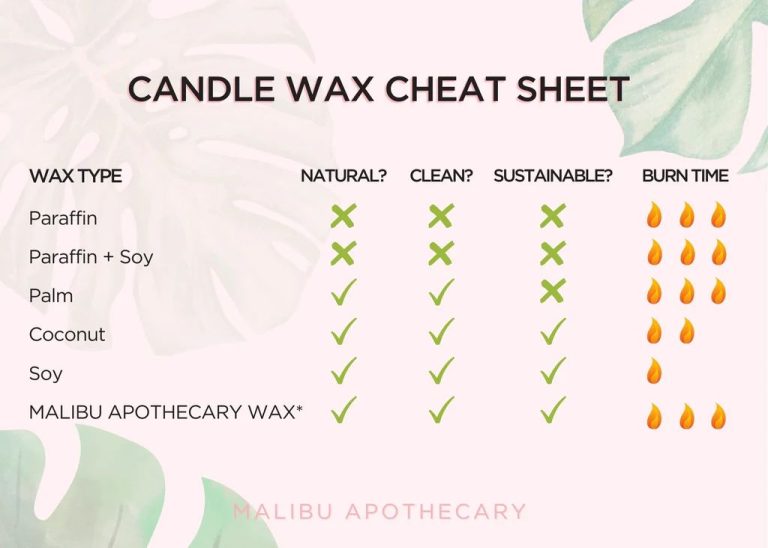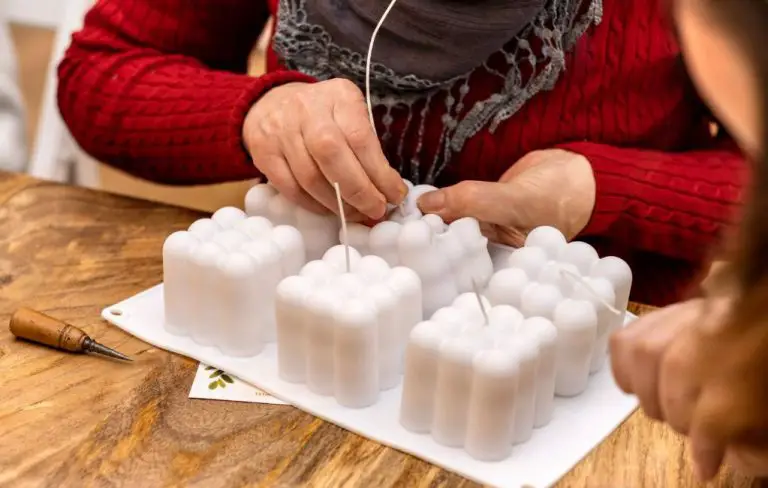Is Soy Wax Better For Candles?
Soy wax has become an increasingly popular alternative to traditional candle waxes like paraffin wax and beeswax. Soy wax is made from soybean oil and offers some advantages over other waxes in terms of cost, safety, and environmental impact.
Paraffin wax, derived from petroleum, has been the dominant candle wax for over a century. However, paraffin wax releases carcinogenic soot and fumes when burned, raising health concerns. Beeswax is a natural wax made by honey bees, but it can be more expensive and challenging to work with compared to soy wax.
Soy wax entered the candle making scene in the 1990s as a renewable and sustainable plant-based option. Soy candles burn longer and cleaner than paraffin, with very little soot. They are also more affordable than beeswax. As demand grows for eco-friendly products, many candle enthusiasts are turning to soy as their wax of choice.
This article will dive into the pros and cons of soy wax compared to paraffin and beeswax. We’ll look at the characteristics of soy wax that make it a popular candle making ingredient and examine how it stacks up against the alternatives.
What is Soy Wax?
Soy wax is a vegetable wax made from the oil of soybeans. After harvesting, the beans are cleaned, cracked, de-hulled, and rolled into flakes (https://www.candlescience.com/learning/what-is-soy-wax/). The oil is then extracted from the flakes and hydrogenated, turning it into a solid wax.
Soy wax is made from soybean oil, which is a renewable and sustainable resource. The beans are grown annually, so the supply of soy wax depends on each year’s yield. This makes it a much more eco-friendly option than paraffin wax, which is a petroleum product.
The main components of soy wax are hydrogenated soybean oil along with some natural additives like palm oil or coconut oil. Soy wax contains no petroleum derivatives, carcinogens, or toxins (https://www.waxpoeticcandlebar.com/blog/why-soy-wax). This clean burning wax produces minimal soot and smoke when burning, making it ideal for candles.
Pros of Soy Wax
Soy wax offers several advantages that make it a popular choice for candle making. Some of the main pros of using soy wax include:
Soy wax is a natural and renewable resource. It is made from soybeans, an annually renewable crop. This makes it a more sustainable option compared to paraffin wax which is made from petroleum, a non-renewable resource (https://thecandlestudio.com/blog/why-choose-a-soy-wax-candle-the-benefits-of-soy-wax).
Soy wax is biodegradable. Since it is plant-based, soy wax will break down through natural processes over time. Petroleum-based paraffin wax does not biodegrade easily (https://www.waxpoeticcandlebar.com/blog/why-soy-wax).
Soy wax is non-toxic. It does not release harmful fumes or toxins when burning like paraffin wax can. This makes soy candles safer to burn indoors (https://www.pureintegrity.com/blog/soy-wax-healthier-choice-candle-addiction.html).
Cons of Soy Wax
While soy wax has many benefits, it also has some drawbacks when compared to paraffin wax. Some of the main cons of soy wax include:
Lower melting point – Soy wax melts at a lower temperature than paraffin, around 115-135°F compared to 135-145°F for paraffin. This means soy candles must be burned at lower temperatures to avoid tunneling.
Softer texture – The softer texture of soy wax makes it harder to achieve detailed shapes and designs. Soy wax candles may lose their shape in warmer environments.
Higher price – Soy wax is generally more expensive than paraffin wax. The growing demand for soy wax has increased prices.
While soy wax may not be ideal for every candle making application, its renewable and sustainable properties make it a popular choice for many candle makers and consumers despite the higher price point.
Paraffin Wax Overview
Paraffin wax is a petroleum-based wax made from refining crude oil. It is the most commonly used candle wax today. Some key facts about paraffin wax:
Paraffin wax is inexpensive and easy to work with. It has excellent oil retention which allows it to hold fragrance very well. Paraffin candles tend to burn longer than other waxes since paraffin melts at a lower temperature.[1] The low melt point also gives paraffin candles a nice pool as they burn.

However, paraffin wax produces more soot than natural waxes like soy or beeswax. The petroleum base also raises environmental concerns. [2] Some consumers prefer to avoid paraffin for health reasons as it can emit VOCs when burned. Properly curing paraffin candles minimizes this, but it remains a drawback.
Overall, paraffin wax is budget-friendly and technically sound for candles. But natural waxes provide an eco-friendly alternative that is growing in popularity.
[1] https://blendedwaxes.com/blog/soy-vs-paraffin-candles/
[2] https://www.slatkinandco.com/blogs/the-slatkin-summary/soy-wax-vs-paraffin-wax-which-is-better
Beeswax Overview
Beeswax is a natural wax produced by honey bees. It is secreted from special glands on the bee’s abdomen and used by bees to build the walls of their honeycomb. Beeswax has been used for thousands of years by humans for a variety of purposes, including candle making, cosmetics, art, and even food preservation.
There are several pros to using beeswax for candle making:
- Beeswax candles burn brighter and longer than other waxes (The Lobo Life). The slow-burning nature means less frequent trimming of the wick which reduces smoke and wax vapor released into the air.
- Beeswax is all-natural. It does not contain any chemicals, dyes, bleaches, or pesticides (Greenerlyfe).
- Beeswax candles produce a lightly honeyed aroma, making beeswax popular for natural home fragrance (The Farmer’s Cupboard).
Some cons of using beeswax for candles are:
- Beeswax is more expensive than other waxes. It can cost 2-3 times more than paraffin wax (The Farmer’s Cupboard).
- The natural honey scent may not appeal to all candle buyers. Adding essential oils can change the fragrance but may diminish burn quality (Greenerlyfe).
- Beeswax comes in limited color options compared to dyed waxes. Achieving bright or dark colors requires high concentrations of dye which can alter burn performance (The Lobo Life).
Comparing Soy, Paraffin, and Beeswax
When choosing between soy, paraffin, and beeswax for candles, there are a few key differences to consider:
Soy wax is made from soybeans. It is a cleaner-burning, renewable and biodegradable wax option. Soy candles tend to burn slower and cooler than paraffin, with a lower melting point. This can make soy wax better for containers candles where you don’t want the wax pooling. Soy also holds scent well. The drawbacks are that soy can be softer and not ideal for detailed decorative candles. It also can produce more soot. Source
Paraffin wax is a petroleum byproduct, making it the least eco-friendly option. However, it is inexpensive and makes a hard candle that holds its shape well. Paraffin burns hotter than soy or beeswax. It can burn clean but does produce some soot. Paraffin works well for decorative pillar candles but can pool deeply in containers. The hot burn makes paraffin good for scent dispersion. Source
Beeswax is all-natural, made by honey bees. It has a lovely natural honey aroma. Beeswax burns the cleanest and longest of the three. It is also biodegradable and renewable. However, beeswax is expensive and can be prone to frosting or blooming on the candle surface. It also burns at a low temperature so does not disperse scent as well. The soft texture works better for votive or taper candles than decorative pillars. Source
Overall, soy wax offers a nice mid-point between paraffin and beeswax in terms of cost, scent throw, and environmental benefits. But personal preference for burn qualities, scent, and budget will determine if soy, paraffin, or natural beeswax is the best choice for any individual candle making project.
Making Soy Candles
Making soy candles is a bit different than making paraffin candles. Here are some tips and guidelines for making high-quality soy candles:
Use the double boiler method to melt soy wax flakes gradually. Heating the wax too quickly can burn it. Melt the wax to 175-185°F. https://www.candlescience.com/learning/how-to-make-a-soy-candle/
Add fragrance oil once the wax has melted and cooled slightly to 130-140°F. Add dye at this point as well if desired. Stir thoroughly to incorporate. https://simplylivingwell.com/blog-home/6irr9h2jr4n4eycp5jecrl5trn9w0x
Pour the wax into containers when it has cooled to 110-120°F. Allow candles to cure 48-72 hours before burning.
Use cotton or wood wicks designed for soy wax to prevent issues like soot. Test wick sizes to find the optimal fit.
Consider adding supplements like vybar or parasoy to modify the wax characteristics. Vybar makes a harder finish and parasoy increases scent throw.
Take precautions like wearing gloves and goggles when handling hot wax. Work in a well-ventilated area.
Start with small batch sizes while perfecting your process. Quality soy candles take attention to detail.
Popular Soy Candle Scents
When it comes to soy candles, there are many delicious scents to choose from. Some of the most popular scent options for soy candles include:
Fruity Scents: Fruits like strawberry, peach, pineapple, and citrus are refreshing and energizing. Brands like Capri Blue offer soy candles in scents like Volcano, which has sweet citrus and tropical notes.
Spice Scents: Warm spices like cinnamon, clove, and nutmeg create cozy, inviting soy candles perfect for fall and winter. Yankee Candle’s Spiced Pumpkin is a popular spicy soy option.
Floral Scents: Pretty florals like rose, lavender, jasmine and lilac can provide a delicate, romantic ambiance. 1803 Candles makes soy candles in soft floral scents like Peony Petals and Lilac Blossoms.
Nature Scents: Outdoor smells like pine tree, ocean breeze and rain capture the freshness of nature. WoodWick Candle’s Fireside Soy candle evokes the scent of a cozy campfire.
No matter what types of scents you enjoy, there are endless options for creating inviting, long-lasting soy candles with your favorite fragrances.
Conclusion
Based on the information presented, soy wax does appear to be a better option than paraffin wax for candle making. Some of the key advantages of soy wax are that it is renewable and environmentally friendly, burns slower and longer, and is non-toxic. Soy wax candles also hold scent better than paraffin. The downsides are that soy wax is softer and can be more difficult to work with. However, with proper wick sizing and Jar selection, high quality soy candles can be produced. Soy wax strikes a good balance between an eco-friendly option like beeswax while still being affordable and accessible like paraffin. For candle makers and consumers concerned about sustainability and non-toxic ingredients, soy wax is likely the best all-around choice.






